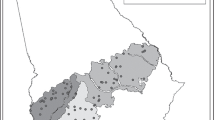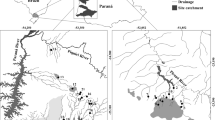Abstract
The Sand Hills subdivision of the Southeastern Plains ecoregion has been impacted by historical land uses over the past two centuries and, with the additive effects of contemporary land use, determining reference condition for streams in this region is a challenge. We identified reference condition based on the combined use of 3 independent selection methods. Method 1 involved use of a multivariate disturbance gradient derived from several stressors, method 2 was based on variation in channel morphology, and method 3 was based on passing 6 of 7 environmental criteria. Sites selected as reference from all 3 methods were considered primary reference, whereas those selected by 2 or 1 methods were considered secondary or tertiary reference, respectively. Sites not selected by any of the methods were considered non-reference. In addition, best professional judgment (BPJ) was used to exclude some sites from any reference class, and comparisons were made to examine the utility of BPJ. Non-metric multidimensional scaling indicated that use of BPJ may help designate non-reference sites when unidentified stressors are present. The macroinvertebrate community measures Ephemeroptera, Plecoptera, Trichoptera richness and North Carolina Biotic Index showed no differences between primary and secondary reference sites when BPJ was ignored. However, there was no significant difference among primary, secondary, and tertiary reference sites when BPJ was used. We underscore the importance of classifying reference conditions, especially in regions that have endured significant anthropogenic activity. We suggest that the use of secondary reference sites may enable construction of models that target a broader set of management interests.





Similar content being viewed by others
References
Bailey RC, Norris RH, Reynoldson TB (2004) Bioassessment of freshwater ecosystems: using the reference condition approach. Kluwer, New York
Barbour MT, Gerritsen J, Snyder BD, Stribling JB (1999) Rapid bioassessment protocols for use in streams and wadeable rivers: periphyton, benthic macroinvertebrates and fish. 2nd edn. EPA 841-B-99-002. U.S. Environmental Protection Agency; Office of Water; Washington
Benton PD, Ensign WE, Freeman BJ (2008) The effect of road crossings on fish movements in small Etowah Basin streams. Southeast Nat 7:301–310
Borcard D, Gillett F, Legendre P (2011) Numerical ecology with R. Springer, New York
Brigham AR, Brigham WU, Gnilka A (eds) (1982) Aquatic insects and oligochaetes of North and South Carolina. Midwest Aquatic Enterprises, Illinois
Cohn JP (1996) New defenders of wildlife. Bioscience 46:11–14
Cuffney TF, Bilger MD, Haigler AM (2007) Ambiguous taxa: effects on the characterization and interpretation of invertebrate assemblages. J N Am Benthol Soc 26:286–307
Davies SP, Jackson SK (2006) The biological condition gradient: a descriptive model for interpreting change in aquatic ecosystems. Ecol Appl 16:1251–1266
Dunne T, Leopold LB (1978) Water in environmental planning. Freeman, San Francisco
Epler JH (2001) Identification manual for the larval Chironomidae (Diptera) of North and South Carolina: a guide to the taxonomy of the midges of the southeastern United States, including Florida. St. Johns River Water Management District
Epler JH (2010) Identification manual for the water beetles of Florida:(Coleoptera: Dryopidae, Dytiscidae, Elmidae, Gyrinidae, Haliplidae, Hydraenidae, Hydrophilidae, Noteridae, Psephenidae, Ptilodactylidae, Scirtidae). State of Florida, Department of Environmental Protection, Division of Water Facilities
ESRI (Environmental Systems Resource Institute) (2009) ArcGIS® 9.2. ESRI, Redlands, California
Feminella JW (1996) Comparison of benthic macroinvertebrate communities in small streams of contrasting hydrologic permanence. J N Am Benthol Soc 15:651–669
Forman RTT, Alexander LE (1998) Roads and their major ecological effects. Annu Rev Ecol Syst 29:207–231
GDNR (Georgia Department of Natural Resources) (2007) Macroinvertebrate biological assessment of wadeable stream in Georgia: standard operating procedures. Environmental Protection Division
Griffith GE, Omernik JM, Comstock JA, Lawrence S, Martin G, Goddard A, Hulcher VJ, Foster T (2001) Ecoregions of Alabama and Georgia. Two-sided color poster with map, descriptive text, summary tables, and photographs). U.S. Geological Survey, Reston, VA, scale 1:1,700,000
Hawkins CP, Olson JR, Hill RA (2010) The reference condition: predicting benchmarks for ecological and water-quality assessments. J N Am Benthol Soc 29:312–343
Herlihy AT, Paulsen SG, Van Sickle J, Stoddard JL, Hawkins CP, Yuan LL (2008) Striving for consistency in a national assessment: the challenges of applying a reference-condition approach at a continental scale. J N Am Benthol Soc 27:860–877
Hughes RM (1995) Defining acceptable biological status by comparing with reference conditions. In: Davis WS, Simon TP (eds) Biological assessment and criteria: tools for water resource planning and decision making for rivers and streams. CRC Press, Boca Raton, pp 31–47
Hughes DL (2005) Development of biological reference conditions of wadeable streams in the major ecoregions and subecoregions of Georgia. Thesis, Columbus State University
Ihaka R, Gentleman R (1996) R: a language for data analysis and graphics. J Comput Graph Stat 5:299–314
Johnson PA, Heil TM (1996) Uncertainty in estimating bankfull conditions. J Am Water Resour Assoc 32:1283–1291
Jones JA, Swanson FJ, Wemple BC, Synder KU (2000) Effect of roads on hydrology, geomorphology, and disturbance patches in stream networks. Conserv Biol 14:76–85
Jordan RA, Wheaton KS, Weiher WM, Hayden TJ (1997) Integrated endangered species management recommendations for army installations in the southeastern United States. USACERL Special Report 97/94, U.S. Army Construction Engineering Research Laboratories, Champaign
Karr JR (1991) Biological integrity: a long-neglected aspect of water resource management. Ecol Appl 1:66–84
Karr JR, Dudley DR (1981) Ecological perspective on water quality goals. Environ Manag 5:55–68
Karr JR, Fausch KD, Angermeier PL, Yant PR, Schlosser IJ (1986) Assessing biological integrity in running waters: a method and its rationale. Illinois Natural History Survey, Champaign, Illinois, Special Publication 5
Kaufman L (2010) A base for war training, and species preservation. New York Times, Feb 22, A1
Kosnicki E, Sites RW (2007) Least-Desired Index for assessing the effectiveness of grass riparian filter strips in improving water quality in an agricultural region. Environ Entomol 36:713–724
Kowalyk HE (1985) The larval cephalic setae in the Tanypodinae (Diptera: Chironomidae) and their importance in generic determination. Can Entomol 117:67–106
Landers JL, Van Lear DH, Boyer WD (1995) The longleaf pine forests of the Southeast: requiem or renaissance? J For 93:39–44
Leopold LB (1994) A view of the river. Harvard Univ Press, Cambridge
Leopold LB, Maddock T (1953) The hydraulic geometry of stream channels and some physiographic implications; USGS Professional Paper 252. United States Government Printing Office, Washington
Loehle C, Wigley TB, Schilling E, Tatum V, Beebe J, Vance E, Van Deusen P, Weatherford P (2009) Achieving conservation goals in managed forests of the Southeastern Coastal Plain. Environ Manag 44:1136–1148
Maindonald JH, Braun J (2007) Data analysis and graphics using R: an example-based approach. Cambridge University Press, Cambridge
Maloney KO, Mulholland PJ, Feminella JW (2005) Influence of catchment-scale military land use on stream physical and organic matter variables in small Southeastern Plains catchments (USA). Environ Manag 35:677–691
Maloney KO, Feminella JW, Mitchell RM, Miller SA, Mulholland PJ, Houser JN (2008) Landuse legacies and small streams: identifying relationships between historical land use and contemporary stream conditions. J N Am Benthol Soc 27:280–294
Markewich HW, Markewich W (1994) An overview of pleistocene and Holocene Inland dunes in Georgia and the Carolinas: morphology, distribution, age, and paleoclimate, U.S. Geological Survey Bulletin no. 2069
McCandless TL (2003) Maryland stream survey: bankfull discharge and channel characteristics of streams in the coastal plain hydrologic region. U.S. Fish and Wildlife Service, Chesapeake Bay Field Office. CBFO-S03-02
McCune B, Mefford MJ (1999) PC-ORD. Multivariate analysis of ecological data, version 4. MjM Software Design, Gleneden Beach, OR
Merritt RW, Cummins KW, Berg MB (eds) (2008) An introduction to the aquatic insects of North America, 4th edn. Kendall-Hunt, Iowa
NCDENR (North Carolina Department of Environment and Natural Resources) (2006) Standard operating procedures for benthic macroinvertebrates biological assessment unit. Division of Water Quality, Environmental Science Section
Omernik JM (1987) Ecoregions of the conterminous United States. Map (scale 1:7,500,000). Ann Assoc Am Geogr 77:118–125
Quist MC, Fay PA, Guy CS, Knapp AK, Rubenstein BN (2003) Military training effects on terrestrial and aquatic communities on a grassland military installation. Ecol Appl 13:432–442
Rankin ET (1995) Chapter 13: Habitat indices in water resource quality assessments. In: Davis WS, Simon TP (eds) Biological assessment and criteria: Tools for water resource planning and decision making for rivers and streams. CRC Press, Boca Raton, pp 181–208
Reynoldson TB, Norris RH, Resh VH, Day KE, Rosenberg DM (1997) The reference condition: a comparison of multimetric and multivariate approaches to assess water-quality impairment using benthic macroinvertebrates. J N Am Benthol Soc 16:833–852
Rosgen D (2007) Watershed Assessment of River Stability and Sediment Supply (WARSSS). Wildland Hydrology. Fort Collins, CO. http://www.epa.gov/warsss/
Rousseeuw PJ (1987) Silhouettes: a graphical aid to the interpretation and validation of cluster analysis. J Comput Appl Math 20:53–65
SAS Institute Inc. (2004) SAS/STAT® 9.1 User’s Guide. SAS Institute Inc. Cary, NC
SCDHEC (South Carolina Department of Health and Environmental Control) (1998) Standard operating and quality control procedures for macroinvertebrate sampling. Technical Report No. 004-98. Bureau of Water, Division of Water Monitoring, Assessment and Protection, Aquatic Biology Section
Schmidt JP (2013) “Sandhills.” New Georgia Encyclopedia. 19 August 2013. http://www.georgiaencyclopedia.org/articles/geography-environment/sandhills
Smith ME, Kaster JL (1983) Effect of rural highway runoff on stream benthic macroinvertebrates. Environ Pollut (Series A) 32:157–170
Stoddard JL, Peck DV, Olsen AR, Larsen DP, Van Sickle J, Hawkins CP, Hughes RM, Whittier TR, Lomnicky G, Herlihy AT, Kaufmann PR, Peterson SA, Ringold PL, Paulsen SG, Blair R (2005) Environmental Monitoring and Assessment Program (EMAP): western streams and rivers statistical summary. EPA 620/R-05/006. Office of Research and Development, US Environmental Protection Agency, Washington, DC
Stoddard JL, Larsen DP, Hawkins CP, Johnson RK, Norris RH (2006) Setting expectations for the ecological condition of streams: the concept of reference condition. Ecol Appl 16:1267–1276
R Development Core Team (2013) R: A language and environment for statistical computing. R Foundation for Statistical Computing, Vienna, Austria. Version 3.0.1. http://www.R-project.org/
Thorp JH, Covich AP (eds) (2010) Ecology and classification of North American freshwater invertebrates. 3rd edn. Academic Press, London
USFWS (2003) US Fish and Wildlife Service (2003) Red-Cockaded Woodpecker (Picoides borealis) Recovery, 2nd edn. Atlanta, GA
Van Sickle J, Huff DD, Hawkins CP (2006) Selecting discriminant function models for predicting the expected richness of aquatic macroinvertebrates. Freshw Biol 51:359–372
Voelz NJ, McArthur JV (2000) An exploration of factors influencing lotic insect species richness. Biodivers Conserv 9:1543–1570
Waite IR, Herlihy AT, Larsen DP, Klemm DJ (2000) Comparing strengths of geographic and nongeographic classifications of stream benthic macroinvertebrates in the Mid-Atlantic Highlands, USA. J N Am Benthol Soc 19:429–441
Whittier TR, Stoddard JL, Larsen DP, Herlihy AT (2007) Selecting reference sites for stream biological assessments: best professional judgment or objective criteria. J N Am Benthol Soc 26:349–360
Williams GP (1978) Bank-full discharge of rivers. Water Resour Res 14:1141–1154
Acknowledgments
We thank Hugh Westbury (Fort Benning, Natural Resources Branch), Chuck Bryan (Fort Bragg, Endangered Species Branch), Michael Juhan (Fort Gordon, Natural Resources Branch), Harvey Belser (Manchester State Forest), Michele Brossett (Georgia Department of Natural Resources), Michael Walters (North Carolina Biological Assessment Unit), George Williams (Osage of Virginia, Inc.), Nancy Jordan (Sandhills National Wildlife Refuge), Brian Davis (Sand Hills State Forest), Michele Elmore and Geoff Sorrell (The Nature Conservancy), and special thanks to Brady Beck (Sandhills Gamelands). We also thank Brian Helms at the Auburn Museum of Natural History for field assistance and Andrew Grosse and Bess Harris at Savannah River Ecology Lab for help with GIS analysis. This project was funded by the Strategic Research and Development Program Project RC-1694. Support was provided in part by Award Number DE-FC09-07SR22506 from Department of Energy to the University of Georgia Research Foundation.
Author information
Authors and Affiliations
Corresponding author
Rights and permissions
About this article
Cite this article
Kosnicki, E., Sefick, S.A., Paller, M.H. et al. Defining the Reference Condition for Wadeable Streams in the Sand Hills Subdivision of the Southeastern Plains Ecoregion, USA. Environmental Management 54, 494–504 (2014). https://doi.org/10.1007/s00267-014-0320-0
Received:
Accepted:
Published:
Issue Date:
DOI: https://doi.org/10.1007/s00267-014-0320-0




